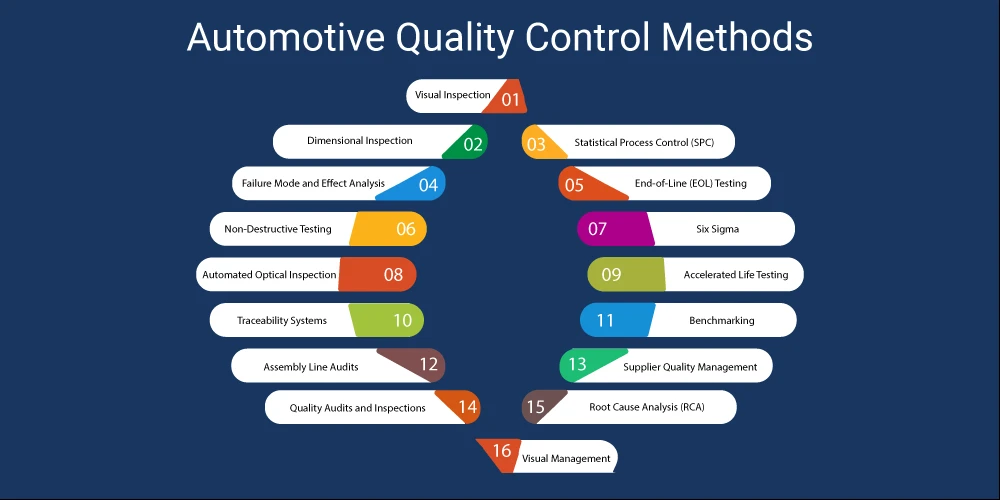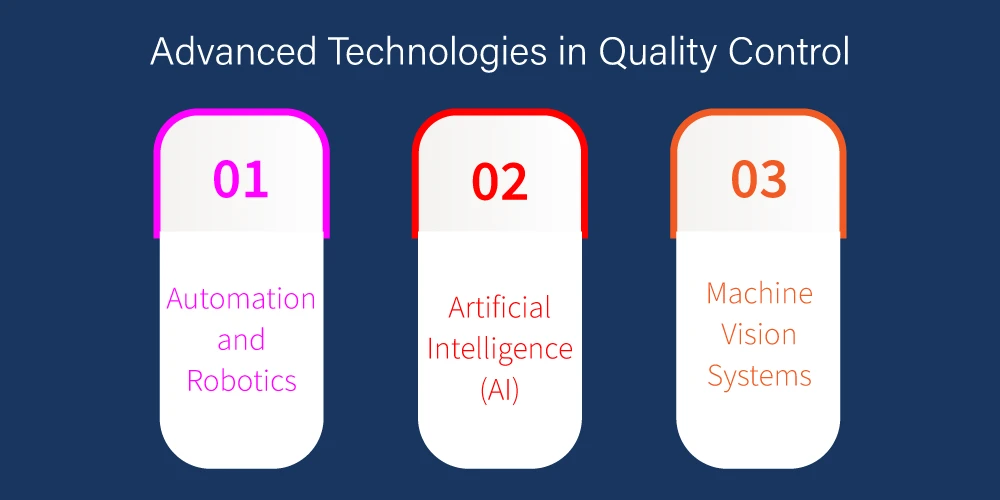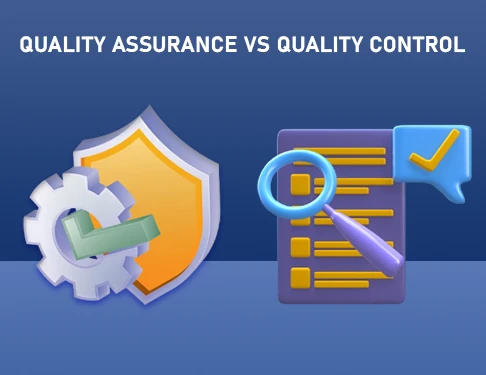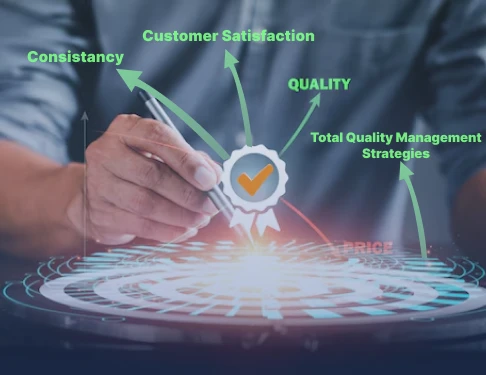Quality Assurance Vs Quality Control
The emphasis on customer satisfaction and continuous quality improvement is central to both quality assurance and quality control. Quality assurance ...
By AMREP | Posted on January 22, 2025
In the automotive industry, product quality is an important issue as it is linked to safety and human life. And the quality is expressed through the customer’s satisfaction in relation to the products and offered services.
A vehicle that meets the highest standards of quality not only ensures the safety of its occupants but also builds long-term trust with consumers. Manufacturers prioritize quality control throughout every stage of production, from design and material selection to assembly and post-sale services.
In this blog, we’ll explore the essential quality control methods and standards that ensure automotive products meet the highest benchmarks for safety, performance, and customer satisfaction.
Quality control on a vehicle is a systematic process aimed at ensuring the vehicle meets predefined standards of performance, safety, and reliability. It involves thorough checks at every stage of manufacturing, including the inspection of raw materials, components, assembly processes, and final product tests.
The goal is to identify and address any defects or inconsistencies early, preventing faulty products from reaching consumers. This ensures that each vehicle performs optimally, adheres to regulatory standards, and provides a safe and satisfactory experience for the driver and passengers.
Must-see: Quality Control:Definition, Significance, and Methods
Quality in the automotive industry has reached new heights. Automakers are shifting their focus to develop electric vehicles (EVs), and the market for battery-powered cars is set for rapid growth. Electric vehicles are becoming the preferred alternative to traditional hybrid gas-electric models, which have long been dominant in the commercial sector. This transition is fueling the expansion of the green movement, which is poised for significant acceleration.
McKinsey & Co. reports that modern vehicles will not only provide insights into customer purchasing behaviors and driving patterns but also lay the foundation for smarter, more efficient future deployments. Given the innovative nature of these new vehicles, manufacturers face the challenge of introducing them to the market with virtually no margin for error. Every aspect, from manufacturing efficiency to product safety, must meet the highest standards—making quality control more vital than ever.
As a result of this new direction, major automakers are proactively identifying and addressing potential production issues to prevent problems once the products reach the market.
General Motors, for example, approached these challenges with the Chevrolet Volt. For GM, success in the future economy will depend on producing vehicles that meet strict environmental standards and deliver low emissions. Therefore, their new electric vehicles must be flawless in design and manufacturing while offering consumers the highest levels of comfort and performance.
Automotive quality control (QC) methods span from traditional manual inspections to advanced automated techniques. The most commonly used methods in automotive quality control are:

Visual inspection is one of the most basic methods used in quality control. It involves inspectors manually checking for defects like scratches, dents, and misalignments on vehicle surfaces or components. This method is essential for identifying visible issues in bodywork and parts assembly.
This process helps ensure that the vehicle’s exterior and interior meet aesthetic and functional standards. It also provides an initial check before moving on to more detailed inspections.
Dimensional inspection ensures that parts and assemblies conform to precise measurements and tolerances. Inspectors use tools like calipers and coordinate measuring machines (CMM) to measure the length, width, height, and other critical dimensions.
This method is essential for ensuring proper fitment of parts such as engine components and body panels. It helps to verify that the components will fit together correctly during the assembly process.
Statistical Process Control (SPC) is a method used to monitor and control the manufacturing process. It utilizes data collection and statistical analysis to detect variations in the process that could lead to defects.
SPC tools like control charts and histograms are used to track performance and identify issues early. This technique helps improve overall process stability and product consistency.
FMEA is a systematic approach to identifying potential failures in products or processes and evaluating their consequences. It helps prioritize risks based on their severity and likelihood of occurrence.
This method is used during the design and development phases, particularly for safety-critical components like airbags and brakes. By addressing potential failures early, FMEA contributes to safer, more reliable products.
End-of-Line (EOL) testing occurs after final assembly to ensure that all systems in the vehicle function as expected. This includes checks for electrical, mechanical, and safety systems such as brakes, lights, and engine performance.
It is crucial for verifying that the fully assembled vehicle meets all quality and performance standards before it is shipped to customers.
Non-Destructive Testing (NDT) techniques are used to examine materials and components without causing damage. Methods like ultrasonic testing and X-ray inspection help detect internal defects, such as cracks or voids, that may not be visible externally.
NDT is essential for ensuring the integrity of critical components such as welds, castings, and structural parts, especially where failure could lead to severe safety risks.
Six Sigma is a data-driven methodology aimed at reducing defects and improving process efficiency. It focuses on achieving near-perfect performance with fewer than 3.4 defects per million opportunities.
By following the DMAIC (Define, Measure, Analyze, Improve, Control) framework, Six Sigma helps manufacturers identify and eliminate sources of variation in production, leading to improved product quality.
Automated Optical Inspection (AOI) uses cameras and advanced image processing software to automatically inspect parts during production. It can detect defects like misalignment, scratches, or incorrect component placement.
AOI is especially useful for inspecting high-precision parts, such as electronic components or circuit boards, ensuring that they meet strict quality standards.
Accelerated Life Testing (ALT) simulates long-term wear and tear on components by subjecting them to extreme conditions, such as high temperatures, vibrations, or heavy loads. This method helps predict the durability and reliability of automotive parts.
ALT is commonly used to test components like engines, brakes, and suspension systems to ensure they can withstand the demands of everyday use over the vehicle's lifespan.
Traceability systems track the journey of every component used in the manufacturing process. Each part is assigned a unique identifier, such as a barcode or RFID tag, that allows it to be traced back to its source.
This method ensures that manufacturers can quickly identify and address any issues related to defective parts, improving quality control and compliance with safety standards.
Benchmarking involves comparing a vehicle’s performance or component quality against competitors or industry standards. It helps manufacturers understand where they stand relative to the market and identify areas for improvement.
By evaluating aspects like fuel efficiency, safety features, and reliability, benchmarking supports continuous improvement efforts and informs design decisions.
Assembly line audits are conducted periodically to ensure that production processes are being followed correctly. Auditors check if each assembly station adheres to the prescribed procedures and quality standards.
This method ensures consistency across the assembly line and helps identify potential issues before they result in defective vehicles.
Supplier Quality Management ensures that parts and materials from external suppliers meet the required quality standards. Before parts are incorporated into final products, they undergo inspections to verify their compliance.
This method minimizes the risk of defects in incoming materials and ensures that the quality of parts from various suppliers aligns with the manufacturer’s standards.
Quality audits and inspections are regular reviews conducted throughout the production process. These checks help ensure compliance with quality standards and provide insights into areas for process improvement.
Audits are typically conducted at different stages, from raw material sourcing to the final assembly of the vehicle, to ensure that quality is maintained throughout production.
Root Cause Analysis (RCA) is used to identify the underlying cause of defects or failures. By investigating why a problem occurred, manufacturers can implement corrective actions to prevent recurrence.
RCA helps improve processes and product designs by addressing the root causes of quality issues rather than just treating the symptoms.
Visual management uses real-time data and visual tools to monitor production performance and communicate quality-related information. Tools like dashboards and status boards are employed on the production floor.
This method helps workers and managers identify issues quickly and make informed decisions to maintain product quality and improve efficiency.
Quality control standards in the automotive industry are set by various organizations and govern manufacturing processes, product design, safety protocols, and environmental impact. Some of the key quality control standards are:
| Standard | Overview | Application |
|---|---|---|
| ISO 9001 | Quality management system standard ensures consistent product quality and customer satisfaction. | Used by automotive manufacturers to ensure operations meet quality management best practices, from design to production. |
| IATF 16949 (ISO/TS 16949) | A quality management standard specifically for the automotive industry, focusing on defect prevention, continuous improvement, and supply chain quality. | Applies to the design, development, production, and installation of automotive-related products. Ensures global consistency in automotive supplier quality management. Itsquality signalling function and facilitative role in moving up the supply chain are the major factors motivating firms to adopt this standard. |
| ISO 14001 | Environmental management system standard helping organizations improve environmental performance. | Automotive manufacturers use it to manage their environmental impact, focusing on reducing emissions and waste in production processes. |
| ISO 26262 | International standard for functional safety, focusing on safety-critical electrical and electronic systems in vehicles. | Ensures that safety-critical systems (e.g., airbags, braking systems) are designed to avoid risks and meet safety requirements. |
| Automotive Safety Integrity Level (ASIL) | Part of ISO 26262, defines safety levels for automotive systems from A (least critical) to D (most critical). | Determines the necessary safety measures for different automotive systems based on their risk levels. |
| SAE J1739 | Provides guidelines for conducting Failure Mode and Effect Analysis (FMEA) in the automotive industry. | Used in the design and development phases to identify potential risks in automotive components and ensure their safety and reliability. |
| ISO 9000 | Outlines the basic principles of quality management, providing the foundation for other standards like ISO 9001. | Establishes baseline quality practices across industries, including automotive, focusing on customer satisfaction and continuous improvement. |
| VDA 6.1 | Developed by the German Association of the Automotive Industry (VDA), focuses on quality management for automotive suppliers. | Applied by automotive suppliers to ensure their processes meet manufacturers’ quality requirements and improve process efficiency and risk management. |
| QS-9000 | A standard developed by the "Big Three" automakers (GM, Ford, Chrysler) to ensure consistent supplier quality across the automotive supply chain. | Historically used for managing supplier quality but now largely replaced by IATF 16949, it laid the foundation for automotive quality management systems. |
| AIAG Standards | Automotive Industry Action Group (AIAG) provides standards for quality management, including APQP, FMEA, and PPAP. | Used by manufacturers and suppliers for quality management tools, especially in North America, focusing on advanced product quality planning and defect prevention. |
| ISO 50001 | Energy management system standard aimed at optimizing energy usage and reducing environmental impacts. | Automotive manufacturers use it to manage energy consumption, reduce costs, and comply with sustainability regulations. |
| Automotive Quality Assurance (AQA) | Focuses on establishing quality assurance processes throughout the automotive production process. | Ensures that quality management practices are maintained consistently across all stages of vehicle production. |
| ISO 13485 | Quality management standard primarily for the medical device industry but applies to automotive manufacturers of safety systems (e.g., airbags). | Automotive companies producing integrated safety systems (e.g., airbags) follow this standard to ensure high-quality production and regulatory compliance. |
Read More: Quality Assurance Vs Quality Control
The automotive industry is constantly evolving, and so are QC methods. New technologies are transforming how quality control is performed.

Robots are increasingly used in automotive manufacturing to perform repetitive tasks like welding or painting. These robots ensure precision and consistency. They also reduce human error, making QC faster and more efficient.
AI is now being used to predict potential defects. By analyzing vast amounts of data, AI systems can identify patterns and predict where issues might arise. This helps manufacturers prevent defects before they occur.
Machine vision systems use cameras and sensors to inspect parts automatically. These systems are often used for tasks like checking the alignment of parts or detecting defects in paint finishes. They offer high accuracy and speed, ensuring that QC is both thorough and efficient.
Augmented Reality (AR) is transforming the automotive industry, enhancing both the design process and the consumer experience. AR integrates digital information with the real world, providing interactive experiences that improve various stages of automotive manufacturing, maintenance, and customer engagement.
AR is significantly changing the way vehicles are manufactured, improving efficiency and reducing errors. AR systems overlay digital instructions, diagrams, and guides directly onto the worker's field of vision, ensuring each step of the assembly is followed correctly.
In the assembly line, AR helps workers by displaying real-time visual instructions for component placement or part assembly. This eliminates the need for physical manuals or complex instructions, making the process faster and reducing human error. For example, an AR headset can show exactly where to position a part or which tool to use, cutting down time spent on figuring out the next step.
Quality control is another area where AR shines in automotive manufacturing. By overlaying digital models onto physical components, manufacturers can detect potential defects or discrepancies early in the process. AR enables real-time monitoring and gives inspectors an intuitive way to spot and correct issues before the product moves forward.
Quality control in the automotive industry is essential for maintaining high standards of safety, performance for customer satisfaction. Practices like SPC, inspection, FMEA, and advanced technologies help to prevent defects, improve efficiency, and protect consumers.
At AMREP Inspect, we are dedicated to providing comprehensiveinspection solutions that help ensure every vehicle on the road is safe, reliable, and of the highest quality. Trust in our expertise to support your commitment to excellence and drive the future of automotive safety and performance.
Contact Us To See What We Can Do
Call Us
Mon - Sat 9.00 - 18.00
Sunday Closed


07 - January 2025
07
January
2025
The emphasis on customer satisfaction and continuous quality improvement is central to both quality assurance and quality control. Quality assurance ...

20 - December 2024
20
December
2024
Quality is a key differentiator for success, and organizations must adopt strategies that drive continuous improvement and customer satisfaction. Total Quality Management...

20 - December 2024
20
December
2024
Organizations constantly strive to improve their processes, enhance customer satisfaction, and achieve operational excellence. One philosophy that has stood the test...
